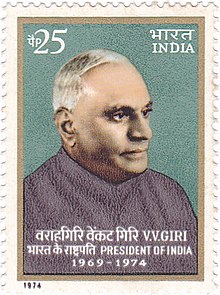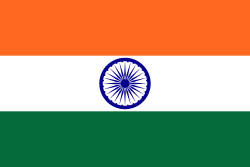Varahagiri Venkata Giri
| Hans Excellence Varahagiri Venkata Giri | |
|---|---|
 V.V. Giri | |
| Indiens 4. præsident | |
| Embedsperiode 24. august 1969 – 24. august 1974 | |
| Vicepræsident | Gobal Swarup Pathak |
| Foregående | Mohammad Hidayatullah (fungerende) |
| Efterfulgt af | Fakhruddin Ali Ahmed |
| Indiens præsident (fungerende) | |
| Embedsperiode 3. maj 1969 – 20. juli 1969 | |
| Premierminister | Indira Gandhi |
| Foregående | Zakir Hussain |
| Efterfulgt af | Mohammad Hidayatullah (fungerende) |
| Personlige detaljer | |
| Født | 10. august 1894 Berhampur, Orissa, Indien |
| Død | 23. juni 1980 (85 år) Chennai, Tamil Nadu, Indien |
| Politisk parti | Indian National Congress |
| Uddannelsessted | University College Dublin Madras Universitet |
| Religion | Hinduisme |
| Informationen kan være hentet fra Wikidata. | |
Varahagiri Venkata Giri (10. august 1894 – 24. juni 1980), ofte omtalt som V. V. Giri, var en indisk politiker, der var Indiens præsident fra 1969 til 1974.[1] Før han blev præsident, var han guvernør i Karnataka fra 1965 til 1967 og Indiens 3. vicepræsident fra 1967 til 1969.
Giri tiltrådte som fungerende præsident da præsident Zakir Husain døde 3. maj 1969.[2] Han fratrådte som fungerende præsident 20. juli 1969, for at stille op som uafhængig præsident ved det efterfølgende præsidentvalg.[3] Han vandt dette valg og var herefter Indiens præsident fra 24. august 1969 til 24. august 1974.[4] I perioden fra 20. juli 1969 til 24. august 1969 var den fungerende præsident Mohammad Hidayatullah.[5]
Kilder og eksterne henvisninger
- ^ "Former Presidents". The President of India. Hentet 2. december 2019.
- ^ K. Natwar Singh (2012-12-20). Walking With Lions: Tales From A Diplomatic Past. HarperCollins Publishers India. s. 13–. ISBN 978-93-5029-899-2.
- ^ Sudarshan Bhatia (4. marts 2014). His Excellency President of India Pranab Mukherjee. Diamond Pocket Books Pvt Ltd. s. 59–. ISBN 978-93-5083-645-3.
- ^ "Former Presidents". The President of India. Arkiveret fra originalen 16. oktober 2014. Hentet 17. januar 2015.
- ^ "Former Vice Presidents of India". Secretariat of Vice President of India. Arkiveret fra originalen 17. oktober 2014. Hentet 3. september 2014.
| ||||||
| ||||||||
| Spire |
|
Medier brugt på denne side
The National Emblem of India is derived from the time of the Emperor Ashoka. The emblem is a replica of the Lion of Sarnath, near Varanasi in Uttar Pradesh. The Lion Capital was erected in the third century BC by Emperor Ashoka to mark the spot where Buddha first proclaimed his gospel of peace and emancipation to the four quarters of the universe. The national emblem is thus symbolic of contemporary India’s reaffirmation of its ancient commitment to world peace and goodwill. The four lions(one hidden from view ) – symbolising power, courage and confidence- rest on a circular abacus. The abacus is girded by four smaller animals—Guardians of the four directions: The Lion of the North, The Horse of the West, The Bull of the South and The Elephant of the East. The abacus rests on a lotus in full bloom, exemplifying the fountainhead of life and creative inspiration. The motto 'Satyameva Jayate' inscribed below the emblem in Devanagari script means 'truth alone triumphs'.
Forfatter/Opretter: India Post, Government of India, Licens: GODL-India
Varahagiri Venkata Giri, Former President of the Republic of India
Forfatter/Opretter: The360degree, Licens: CC BY-SA 4.0
Icon for stubs about Indian political personality


